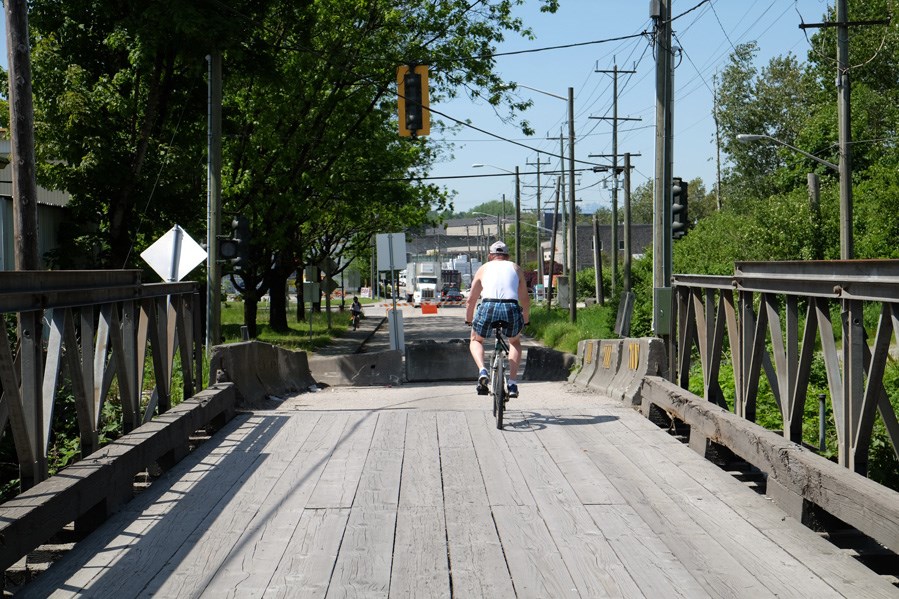Installation of a new single-lane Bailey bridge has stalled while New Westminster and Coquitlam hammer out plans for the controversial corridor.
The City of New Westminster issued a press release on June 23 informing the public that the existing Bailey bridge would be closed to all vehicles, cyclists and pedestrians from June 30 to July 23 so a one-lane crossing could be put in place. The July 2 decision by an arbitrator considering the dispute between New Westminster and Coquitlam has resulted in the bridge’s installation to be put on hold.
“There is a 60-day period from the date of the arbitrator’s decision for the parties to prepare an implementation plan. We are currently in discussions with our colleagues at the City of Coquitlam as to the type and design of the crossing,” said Jim Lowrie, the city’s director of engineering. “The biggest part of that is determining the most cost-effective solution. We are going through that process right now.”
Lowrie said installation of the one-lane crossing has been put on hold temporarily while New Westminster and Coquitlam determine the best two-lane configuration for a crossing through the Braid industrial area.
“We are looking at configuration of bridges and costs, and what’s the best approach,” he told The Record July 15. “I don’t have a timeframe at this time. …It depends on the type of structure that we put in there.”
New Westminster has long maintained that the area should be served by a one-lane bridge because of traffic and train movements through the area, but arbitrator S. Glenn Sigurdson sided with Coquitlam and supported a two-lane structure. Whether the two lanes are provided by a one-lane structure or two single-lane crossings is something that can be determined by the cities.
“We are having very good discussions and hope to have mutual approach, hopefully within the next week or so,” Lowrie said.
Before the arbitration process got underway, the City of New Westminster had been in discussions with the province about borrowing a temporary bridge. The transportation minister later stated the province would only lend the crossing to the city if it agreed to have a second crossing.
New Westminster asked the province to reconsider its condition for a second crossing, and when that didn’t happen, acquired a bridge on its own so it could reopen the corridor that’s been closed to vehicles since March.
“I think it was the best decision at the time,” Lowrie said. “As you know we had an offer for a temporary loan from the ministry but that was withdrawn. To put a crossing in as quickly as possible, that was seen to be the only option available to us.”
The city has spent about $175,000 on site preparation and materials related to the single-lane crossing. Some members of city council still believe that bridge can be used.
“I have no intention of abandoning that. That achieves what we want to achieve, opening that up for traffic that needs to access the industrial area. Let’s try to get an agreement with Coquitlam how we achieve the second phase of it,” said Coun. Chuck Puchmayr about a second lane. “I think at the end of the day it’s up to us. We have been told it needs two lanes there – how we do it is entirely up to us.”
While the single crossing could be installed immediately, Mayor Wayne Wright said it could be months before the connection between the two cities is reinstated if the city waits for a new two-lane crossing.
“What they have there now probably can be added to to have it doubled,” he said. “There is a company, that’s what they specialize in. Our people are speaking to them.”
Although the bridge is located within the Royal City’s boundaries, New Westminster and Coquitlam have shared costs related to the bridge as it’s an inter-regional roadway. New Westminster paid for the single-lane structure on its own, as it wasn’t something supported by Coquitlam.
“Our desire is to get that one in place and get it done in such a way that it wouldn’t impede a second structure,” Puchmayr said. “It’s quite an easy fix, we think. I think the second one would be just as easy.”
Lowrie said the city hopes to use “as much of the materials there now” as possible in the final solution for the Bailey bridge replacement project. While the crossing is closed to vehicles, it is still open for pedestrians and cyclists.



